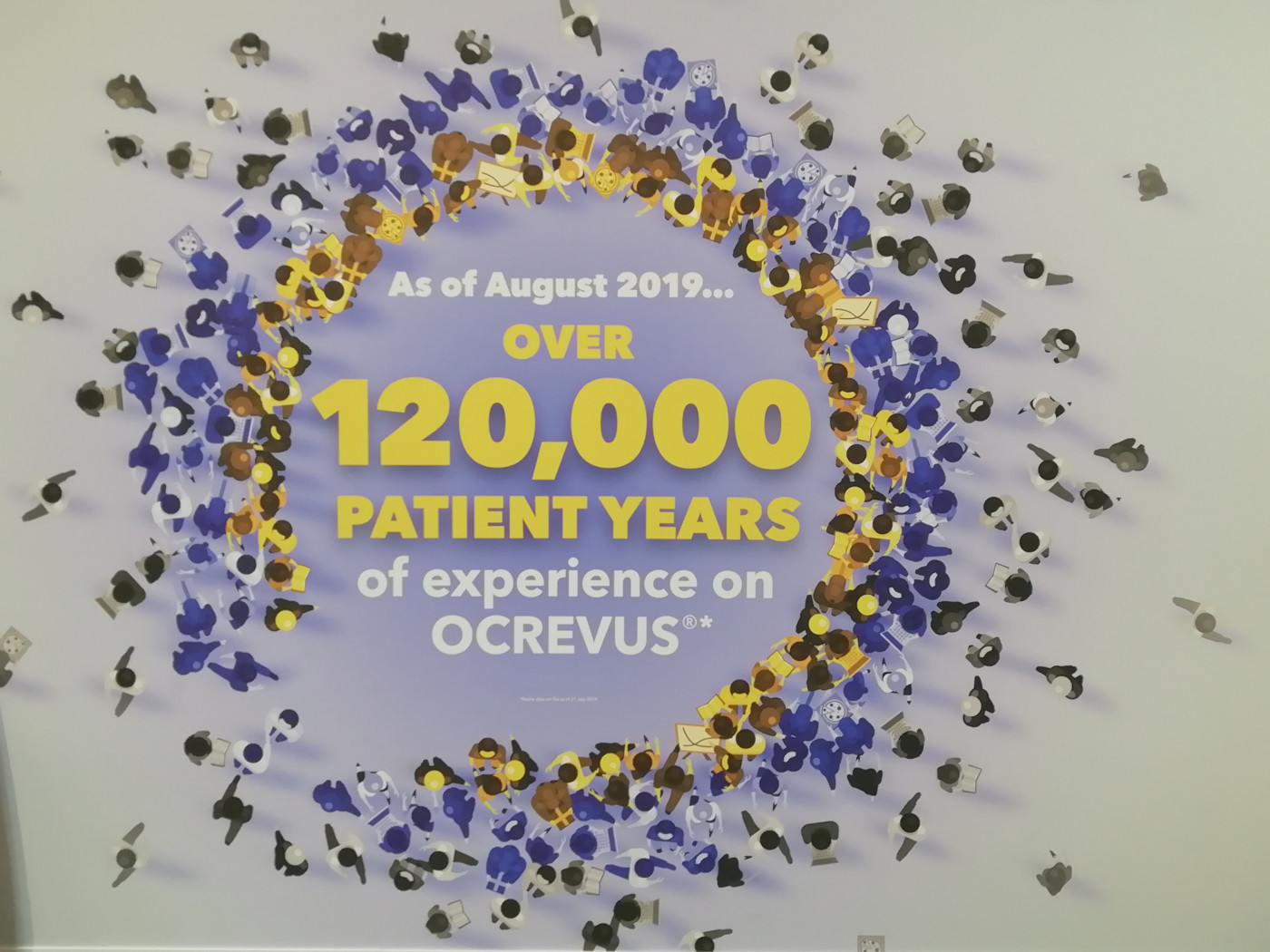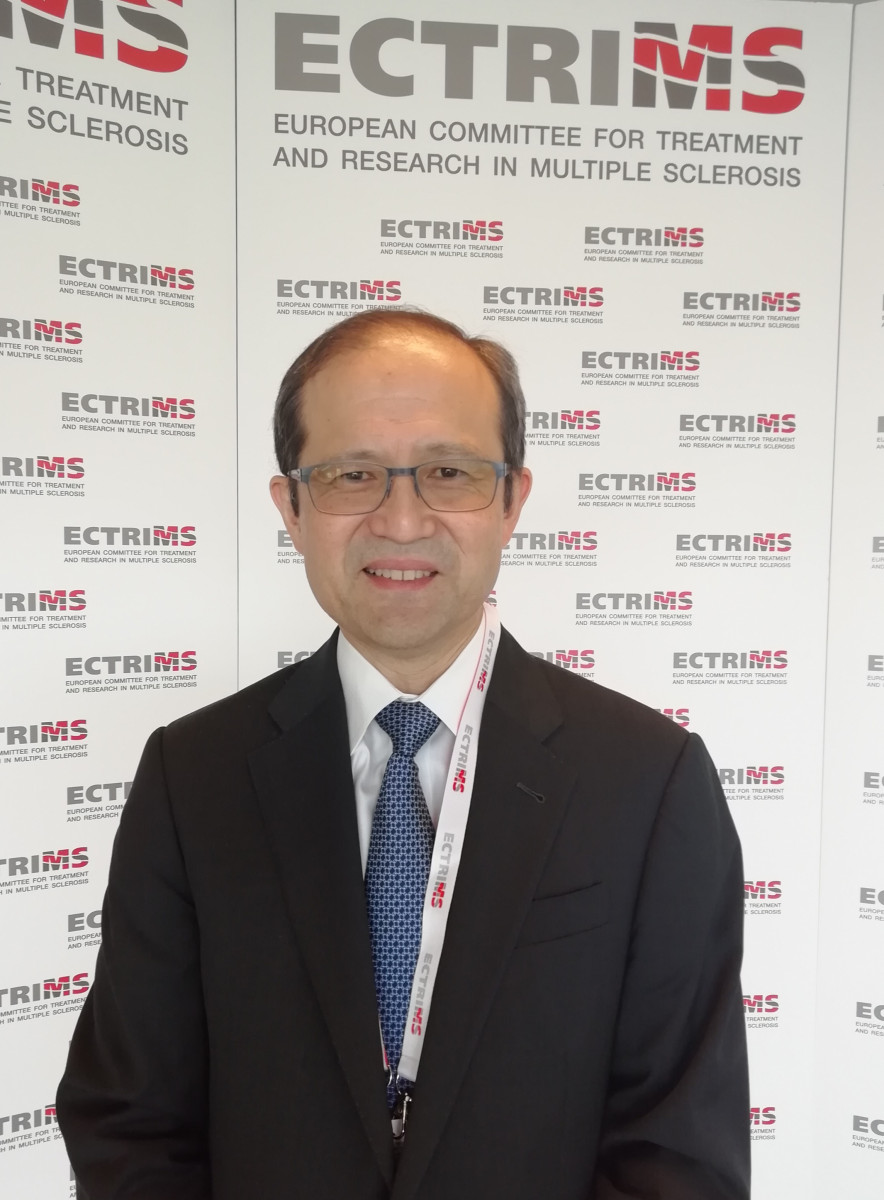#ECTRIMS2019 – Ocrevus Living Up to ‘Game-changing’ Moniker, Genentech’s Hideki Garren Says in Interview
Written by |

#ECTRIMS2019
Two years after the approval of Ocrevus (ocrelizumab), the latest data continue to support the benefits of the so-called “game-changing” therapy in multiple sclerosis (MS), while new insights highlight its neuronal protective effects and safety.
Multiple Sclerosis News Today had the opportunity to speak with Hideki Garren, MD, PhD, Genentech’s global head of MS and neuroimmunology, to get his take on the latest information on Ocrevus, at the 35th Congress of the European Committee for Treatment and Research in Multiple Sclerosis (ECTRIMS), held Sept. 11–13 in Stockholm.
Ocrevus, a humanized antibody that selectively targets and reduces the numbers of CD20-positive B-cells, is the only treatment approved for both relapsing MS, and primary progressive MS (PPMS). The therapy is marketed by Genentech, a subsidiary of Roche.
Effects on disability progression
Data presented at this year’s ECTRIMS conference compile the results of the main trial — the Phase 3 ORATORIO trial (NCT01194570) in PPMS patients — and an open-label extension study, and indicate that earlier and continuous treatment with Ocrevus leads to greater and more prolonged slowing of disability progression — seen for up to 6.5 years — in people with PPMS.
Discuss the latest research in the MS News Today forums!
Data in relapsing MS patients showed a similar result — six years of Ocrevus treatment also reduced the risk of disability progression and, as was seen in PPMS patients, this effect was sustained over time.
“What’s new here is that we’re showing that earlier treatment and continuous treatment leads to better long-term outcomes, so in both the relapsing MS study and the PPMS study,” Garren said.

Hideki Garren, neurologist and Genentech’s global head of multiple sclerosis and neuroimmunology. (Photos by MS News Today)
“What’s really exciting is that in the PPMS study, what we show is that we have a delay to wheelchair,” he added.
Data show that at the end of 6.5 years of treatment, PPMS patients who started earlier on Ocrevus have a 42% lower risk of becoming wheelchair-bound (EDSS disability score of 7 or higher), results Garren considers “really, really exciting and obviously really important for patients.”
Other trial data shared at ECTRIMS showed that Ocrevus lowers blood levels of neurofilament light chain (NfL), a marker of nerve cell damage, following 96 weeks of treatment — both in relapsing MS patients, compared with Rebif (interferon beta-1a), and in PPMS patients, compared with placebo.
With Ocrevus, “you see a significant reduction in the NfL levels down to the healthy control level,” Garren said.
He also noted that NfL levels in these studies were measured in blood collected from patients.
“Most of the research on NfL has been in cerebrospinal fluid [CSF, the fluid surrounding the brain and spinal cord, usually collected by spinal tap], but this is blood. This is a novel way to measure NfL. In both relapsing MS and PPMS studies, we saw that there is a reduction in the blood of NfL with Ocrevus treatment.”
NfL’s potential as a predictor of MS progression has been a much-discussed topic lately in the MS sphere, as an association has been reported between NfL and the degree of disability patients later develop.
According to Garren, NfL could potentially become an important biomarker, but at this point, “it’s an exploratory biomarker. We need to do more studies; we need to investigate it further, but yes, it potentially could be a biomarker for disability progression.”
Regarding other efficacy data presented at ECTRIMS, results from two Roche-sponsored Phase 3 trials — OPERA I (NCT01247324) and II (NCT01412333) — showed that, unlike Rebif, treating relapsing MS patients with Ocrevus is not associated with retinal thinning, specifically, the loss of the nerve fibers located at the innermost layer of the retina in the eye.
Retinal thickness is being investigated as a tool for assessing disease activity and progression. Because the data show a link between retinal thinning and whole-brain volume loss, researchers believe Ocrevus has a protective effect on nerve fibers.
Ocrevus’ safety profile
Progressive multifocal leukoencephalopathy (PML) is an opportunistic viral infection of the brain, often fatal, that has been associated with some MS therapies — namely Biogen‘s Tysabri (natalizumab) and Tecfidera (dimethyl fumarate), and with Novartis‘ Gilenya (fingolimod).
A poster presented at ECTRIMS showed that, as of July 31, seven confirmed PML cases have been identified in patients treated with Ocrevus. The study, however, suggests that all these cases are due to “carryover PML” caused by prior treatment with Tysabri (six cases) and Gilenya (one case).
“I just want to be clear that we have had no PML cases associated with Ocrevus; these are all carryover cases.” According to him, these seven patients “had evidence of PML on those treatments [Tysabri and Gilenya] before switching to Ocrevus.”
The neurologist also emphasized that “safety is of paramount importance for us at Roche,” and that any safety events are thoroughly investigated and reported to the authorities.
As with any immunomodulatory therapy, “physicians should be vigilant for any suspected signs” of PML or any other opportunistic infections Garren said, adding that he encourages physicians to “diligently look for cases” and follow the label guidance.
Regarding other safety concerns, as an anti-B-cell therapy, Ocrevus can lead to a reduction in the blood levels of immunoglobulins (Ig), commonly known as antibodies. This, in turn, may increase a person’s vulnerability to infections.
Data presented at ECTRIMS — based on results from the three Phase 3 trials ORATORIO, and OPERA I and II — showed that taking Ocrevus for more than six years is linked to lower levels of IgG (the most abundant type of antibody) in some PPMS and relapsing MS patients. However, despite this decrease in IgG, the rates of serious infections remained low and all were resolved with standard care.
Garren emphasized that “for the vast majority of patients receiving Ocrevus, there is no reduction of IgG levels.”
Nonetheless, given the known association between low IgG and potential serious infections, physicians and patients need to be aware of this link, he said, but clinically “there’s nothing to do in terms of monitoring patients or anything like that.”
Infusion regimen
The U.S. prescribing information for Ocrevus recommends that patients initially receive 300 mg infusions, administered over 2.5 hours, followed by single 600 mg infusions over 3.5 hours every six months.
In addition, patients need to come to the clinic before the infusion to receive pre-medications, and then stay for monitoring after the procedure.
As Garren pointed out, not only does this take a lot of patients’ time, but it also limits treatment time for other patients.
Roche, therefore, has a number of ongoing studies testing shorter infusion times, based on the company’s “desire to improve patient and healthcare experience,” Garren said.
Preliminary data presented at ECTRIMS showed that a shorter infusion time — a 600 mg dose Ocrevus infused over two hours — is not associated with an increased risk of serious, severe, or life-threatening infusion-related reactions in relapsing-remitting MS (RRMS) patients.
This is “great news for the preliminary data,” Garren said, emphasizing that other studies are underway, “looking at reducing the infusion time, because, again, we want to improve the patient experience.”
A true ‘game-changing’ therapy?
At the time of its approval in 2017, Ocrevus was called a “game-changing” therapy in the MS treatment landscape. Looking back over the past two years, has the medicine lived up to that expectation?
“Short answer … is yes,” Garren said.
He cited Genentech’s track record of more than 120,000 people treated with Ocrevus worldwide so far and emphasized that “the safety remains as we saw in the control trials. The benefit-risk remains very favorable and very positive, so yes, we think that this has improved [MS] patients’ long-term outcomes.
“If you look at the U.S., Ocrevus now is the number one prescribed drug for new treatment, as well as those switching from another treatment. The data speaks for itself,” Garren concluded.





